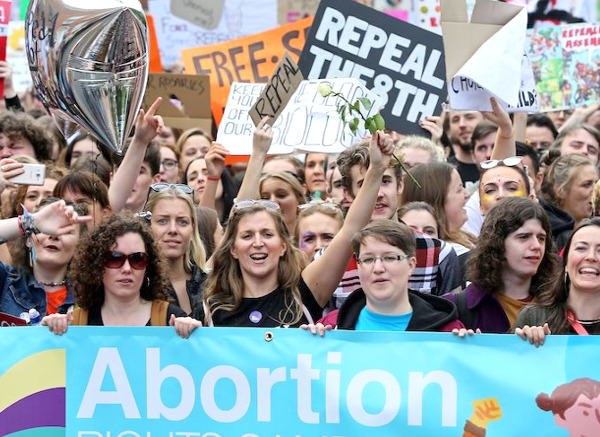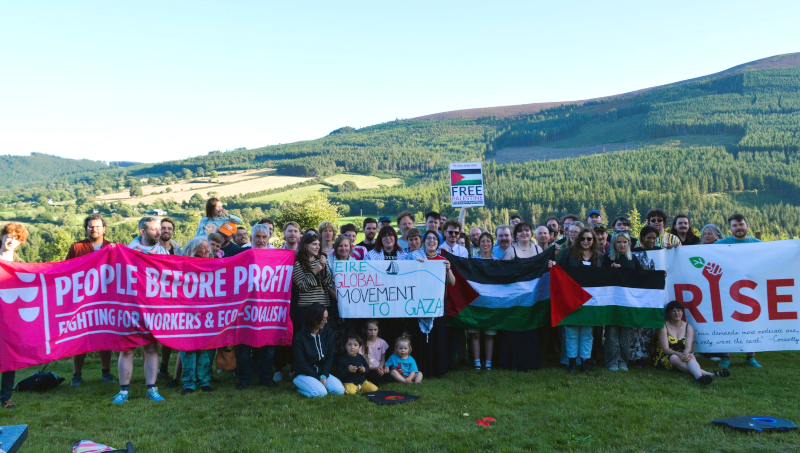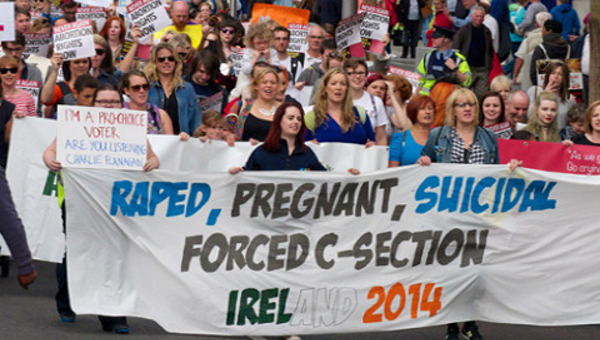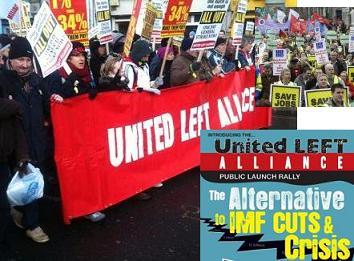Landslide Victory for Abortion Rights in Ireland
“A stunning victory” was how I described the results from the referendum on removing the constitutional ban on abortion in an Irish Times article on Monday 28th. The vote for lifting the ban was passed by a resounding two-thirds majority of 66.4 per cent for Yes. The Irish people have declared in this vote that the sanctimonious hypocrites of the pro-life campaign are no longer free to judge and shame women for deciding what is best for their lives.

It wasn’t a sweetness and light campaign. It was vicious, despite the playing down by the Yes campaign of the behaviour of many in the No camp. Exit polls showed 42 per cent of voters were influenced by the personal stories from women. Reading this I was glad that I told my story of having an abortion when I was a young woman.1 I decided to tell my story as I was tired of the intimidation and shaming of women who had abortions. Many individuals, particularly young women in the campaign, thanked me. It meant a lot to them to hear a woman from another generation speaking out.
The Scale of the Yes Vote
What we’re witnessing is a sea change. A majority in all areas of the country voted for Repeal except in one constituency where there was a very narrow defeat and it’s worth noting this constituency has the highest youth migration in the country. Dublin voted 75.46% Yes, showing that more than three quarters voted YES in the capital city with other urban centres turning out votes of over 72%. Several poor working-class Dublin areas registered a massive 80% + vote for Repeal. The urban-rural divide crumbled, turning out a 63% for Yes.
The results from across the country marked a decisive shift and the RTE Behaviour and Attitudes exit poll showed another spectacular shift, 84% of those who had voted Yes said they had done so on the basis of a woman’s right to choose. This mammoth shift was being confirmed on a daily basis from canvassers on doorsteps where the most common reason given for voting Yes was that of giving choice to a woman in a crisis pregnancy.
There was emotional drama at the airports as young Irish people came home to vote, travelling from Britain, Europe, Australia, Japan and Brazil just to vote. This demonstrated the passion for repealing and that people were against the persecution of women possibly facing14 years in prison for taking illegal abortion pills in their bedrooms or for travelling to Britain for an abortion.
The Background to the Stunning Win
The death of Savita Halappanavar almost six years ago, resulting from the refusal to grant her an abortion after several requests made by her and her husband gave rise to angry mobilizations and the start of a movement to repeal the 8th Amendment from the Constitution. Her tragic death occurred against a background of several other women being denied an abortion and dragged through the courts over the past 2 decades.
These cases lit a spark and a vibrant young women’s movement called a demonstration called Strike4Repeall on International Women’s Day 2017 and other dates. It was large, militant and consisted of young women, many of whom were school age. Marches took place in centres around the country, they brought a new energy to the issue.
An important underlying factor in these mobilizations was the alienation of young people from the Catholic Church and a state that had failed them. The MeToo mobilizations in solidarity with a female rape victim after 3 well known rugby players were acquitted and the global anger over the violence against women helped fuel the repeal movement. They were a number of impressive demonstrations but to date there isn’t as of now an organized women’s movement.
The massive victory in the Marriage Equality referendum in 2015 gave women and pro-choice groups such as the Abortion Rights Campaign the determination to push ahead for repeal. There was a myriad of reasons for the landslide result not least the litany of religious orders torture and abuse of women and children in orphanages, industrial schools, mother and baby homes and clerical sex abuse where paedophile priests were moved around to continue abusing more vulnerable children with the church refusing to pay compensation to their victims.
A Future for the Catholic Church?
There has been a massive decline in attendance at Mass and, as believer’s disgust with the litany of abuse grew, they abandoned the church. It has been left reeling by the referendum results, it is somewhat facing a doomsday scenario. In 1983, during the last referendum that inserted the amendment into the constitution, Church attendance was around 80%. The radical change is highlighted in the results from the exit poll from the RTE the state broadcaster. It’s exit poll showed that just 12% said their religious views as an influence on how they voted.
The answer to why this has occurred lies in its decades’ long abuse of children and women in its care. From 1994 to this day, a series of child abuse scandals showed cruel and inhumane treatment by religious orders against children and women. Continuous revelations of brutality in industrial schools, Church-run Mother and Baby homes and, in 2014, the revelation that 796 babies and toddlers who died from disease and malnutrition while in the care of religious orders were buried in a septic tank. 1,000 children had been sent for illegal adoptions in the United States, without their mothers’ consent and children were used in drug trials and the money made from these transactions syphoned off to fund exclusive private colleges. This brutal history and its dogmatic teachings on women’s sexually and reproduction was firmly rejected by the electorate.
Their comments in the aftermath of the referendum result are an indication of how removed the church is from the population. Just two days after the referendum, a Bishop discussing the implications of the referendum urged Yes-voting ‘sinners’ to get themselves to a confession box to repent. This led to uproar. And a statement from the Archbishop of Ireland asked whether Catholic-run schools were “delivering for the investment we make in faith development.” He went on to say that many would see the referendum result as proof that the church was regarded with “indifference” and had no more than a marginal role to play in society’.
All this points to crisis and the church undergoing a complete dilemma as to how it is going to shore up its base. 90% of youth have rejected church dictates on abortion and voted Yes. The relationship between the church and state is strained. The Catholic Church has been the reliable base for conservatism through its control of schools and of major hospitals including maternity hospitals. It still controls them which is an issue for the campaign to address and a priority that it wrests control from them.
The No Campaign
A very extreme minority in the No camp are now well organized but despised by a significant section of the population. The No campaign consisted of a number of well-funded organizations. Allied with it were various crackpot groups who did their own freelance operations which damaged the No campaign but the overall leadership came from the Iona Institute, a very conservative Catholic group claiming charitable status.
Campaign activists accused the state broadcaster of having a very cosy relationship with the No side as they appeared on all main radio and TV programmes and were treated with kid gloves. There has been a pretence in the media that the Catholic Church was not involved in the campaign, this is patently untrue; in the early days No campaigners were invited to speak to congregations during Mass and while this practice stopped before polling day, priests continued to advocate for a No vote . I made a research visit to my local church where during mass the priest read the Archbishop’s statement calling for a No vote to the elderly congregation, this was the Sunday before polling day. There was no walk out but the majority of the elderly people when leaving the church refused No literature from an elderly man. At a First Communion service in a country town, parents walked out when the priest started talking about the referendum. The sordid posters and material funded by American and British far right religious groups appalled people forcing the No campaign to distance itself from them.
Together for Yes Campaign
Together for Yes was the main national campaign group working for a Yes vote. It was an amalgamation of several organizations and political parties and included the main government parties. The key HQ workers were professional strategists, some of whom had worked in NGO’s or with the discredited Labour Party. Their message was soft focussed on the theme of Care, Compassion, Trust. Consequently, its publicity was watered down and obscure with posters saying Sometimes a private matter needs public support. Vote Yes.
This approach left many activists on the ground feeling ill at ease with the campaign. It focussed on the hard cases of fatal foetal anomaly, rape and incest. The activists out doing the hard slog felt it was not sharp enough as it wasn’t answering the issues they were facing on doorsteps. The reluctance to mention the word abortion was evident and only in the last days of the campaign was the issue of choice for women addressed. The posters and literature of two main left organizations Solidarity, People Before Profit and Rosa a socialist women’s group aligned to Solidarity emphasized the right to choose.
The Implications of the Vote for North
The landslide result will focus attention on the North of Ireland where abortion is illegal. The reactionary Democratic Unionist Party (DUP) is opposed to abortion. The DUP, which is propping up Theresa May in Westminster might be expected to threaten to bring down the Tories if there’s pressure on extending British abortion rights to Northern Ireland. However, the DUP didn’t preach fire and brimstone last year, as is their form on moral questions, when it was agreed to give women in the North free NHS abortions in Britain. However, it may be a different matter having abortion clinics operating in their own backyard.
The Sinn Fein leader Mary Lou McDonald played a prominent part in the campaign in the south, she has promised to tackle the abortion issue in the North. It won’t be easy. She could join with forces already fighting on the issue and build a vigorous campaign for abortion but this is somewhat unlikely given the weak position Sinn Fein has on abortion and the dilemma that the collapsed Northern Assembly has for the party.
Failure to get it back up and running has posed serious questions for Sinn Fein as it’s whole legitimacy is based around the success of the Peace Process and the power sharing arrangements in the Good Friday Agreement. Right wing bigoted unionists wouldn’t allow limited laws on the Irish language so it’s unlikely given their pious obscurantist antiwoman policies that they won’t put up concerted opposition to having abortion clinics operating in the North. They are similar in ideology to the bigoted No campaign in the South.
In any event, the landslide vote in the South will have a major impact. The stunning vote is particularly welcome given the international context, where right-wing populism is on the rise in Europe and the Trump administration is imposing curbs on abortion rights in the United States. It will encourage women and pro-choice groups and will be a blow to the anti-abortion forces in these countries that so called Catholic Ireland could reject with such a decisive popular vote its stringent anti-abortion law.
What Next?
The result has opened up a space where women in the South can pursue their demands for proper health care and abortion services. At present the level of health care and social services is dependent on what’s left over after paying the bank debt. Young people won’t accept this argument that there is no money to fund health services and high quality care for women having pregnancy terminations.
The recent handing over of a new National Maternity Hospital to an order of nuns is a huge contradiction. The Government has not taken any steps to take over ownership. The repeal vote was to get the church out of women’s reproductive lives yet this is clear evidence of church state control.
The young campaign activists may be quickly jolted into confronting the reality of Church. State integration and the reality of Troika imposed austerity. A majority of campaign activists were under 30, they went door to door talking to people of all ages about repeal and the proposed abortion legislation. They showed great courage and the abuse they received from the No side was a shock and an awakening. The misogynist material and posters of the No side gives them a view of the hard-Catholic right. They responded by mobilizing, making the campaign visible on the streets at traffic lights and busy areas. The response from passing motorists was astounding – a continuous hooting of car horns and raised fists.
It was clear during the last week to 10 days of the campaign that we were witnessing an upsurge of rejection of the old cruel pious hypocrisy that’s haunted Ireland since the founding of the state. The national body overseeing Together for Yes nationally was quite timid and apologetic in its approach to the aggressiveness and outright lies of the No campaign. There were many lines of attack the Yes side never responded to, for example a leading spokesperson of the No side advocated all-out war on Iran and Iraq some years ago which was then covered in the media but he was never called out on his ‘pro-life’ credentials. Another leading advocate for the no side was a spokesperson for one of the Bishops and while he was working in that capacity the Bishop was covering up child sex abuse.
In the week before the vote the recently retired former General Secretary of the Irish Congress of Trade unions (ICTU) David Begg called for a No vote, saying that social support should be put in place for women and children. He is rumoured to be involved in the Catholic secret society Opus Dei. Given that the ICTU had negotiated unprecedented cuts in health, education and other social supports and had tied the union movement into support for draconian austerity measures to bail out the banking system, his call had little or no effect on the referendum outcome. The current ICTU leadership denounced Beggs attack on their position of support for Repeal, but not his hypocrisy on the question of social support for women and children as they all agree that the unions must confine their ambitions within the savage austerity offensive dictated by the institutions of the European Union. Their support for women’s rights are limited by their support for the capitalist offensive.
As the campaign developed the energy and enthusiasm was palpable. Young people who had maybe never spoken to a stranger before were discussing the difficult issue of abortion with people of all ages. Their energy knew no bounds, they canvassed often in groups of 50 plus, held impromptu visibility and information stalls. There were lots of initiatives such as Walk in Her Shoes March from the city centre to the airport with many women carrying suitcases to depict the journey that at least 9 women make every day to Britain for abortions. This was a defiant moving occasion. It was organized by Rosa – a socialist feminist women’s group attached to the Socialist Party. These activities were a move away from constituency work. The character of the campaign changed from getting the vote out to include more assertive demands for a woman’s right to choose.
There’s a strong appetite to continue to meet and organize. The task now is the necessity of organizing a conference to discuss the proposed legislation and the views of the campaign on how it should be implemented and the way forward. The campaign has a lot of work to do and needs to carry on but it will not be successful if the new generation of young activists are left on the side-lines as cheerleaders listening to seasoned activists. A free quality service staffed by doctor’s nurses and counsellors with specific training in the area is necessary.
At present, 17 per cent of the population in Ireland are immigrants. Some of them without the right to travel such as asylum seekers in Direct Provision, this makes speedy implementation of the abortion legislation an imperative. Women will not be able to gain control over their lives without control of their reproduction. We cannot rely on capitalist governments to implement the changes for us, we must rely on our own strengths fighting together in a mass women’s movement which includes immigrant and working class women and which looks for revolutionary socialist answers to the issues that face us as women. •
This article first published on the International Viewpoint website.
Endnotes
- Irish Times, “‘There must be more of us out there. We must know each other’,” 17 May 2018.




